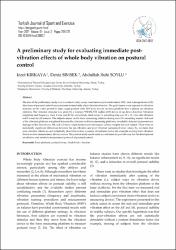| dc.contributor.author | Kırkaya, Izzet | |
| dc.contributor.author | Sımsek, Deniz | |
| dc.contributor.author | Soylu, Abdullah Ruhi | |
| dc.date.accessioned | 2019-10-22T20:07:45Z | |
| dc.date.available | 2019-10-22T20:07:45Z | |
| dc.date.issued | 2017 | |
| dc.identifier.uri | http://www.trdizin.gov.tr/publication/paper/detail/TWpjME1UQXlNZz09 | |
| dc.identifier.uri | https://hdl.handle.net/11421/22408 | |
| dc.description.abstract | The aim of the preliminary study was to evaluate body sways simultaneously in mediolateral (ML) and anteroposterior (AP) directions of postural control measurements immediately after vibration stimulus. The participants were exposed to vibration stimulus for 60 s time period in static squat position with 1500platform. The vibration stimulus was given by a Compex WINPLATE Galileo 2000 device in up-down direction. Vibration amplitude and frequency were 2 mm and 40 Hz respectively. Each subject’s recording time was 70 s (5 s rest, 60s vibration and 5 s rest) for all sessions. The subjects stayed on the force measuring platform during each 70 s recording session. Soft mat of the vibration platform was placed between the vibration and force measuring platforms for reliable data and to prevent any damage on the force device. ML and AP force values normalized with respect to body weights for each subject. There were no statistically significant differences between the pre-vibration and post-vibration normalized force values. So, we claim that post-vibration effects are not statistically detectable unless a posture disturbance factor (for example moving from vibration device to force measurement device) occurs. The present study can be used as a reference to pave the way for the development an effective and sensitive measurement protocol of postural control | en_US |
| dc.description.abstract | The aim of the preliminary study was to evaluate body sways simultaneously in mediolateral (ML) and anteroposterior (AP) directions of postural control measurements immediately after vibration stimulus. The participants were exposed to vibration stimulus for 60 s time period in static squat position with 1500platform. The vibration stimulus was given by a Compex WINPLATE Galileo 2000 device in up-down direction. Vibration amplitude and frequency were 2 mm and 40 Hz respectively. Each subject’s recording time was 70 s (5 s rest, 60s vibration and 5 s rest) for all sessions. The subjects stayed on the force measuring platform during each 70 s recording session. Soft mat of the vibration platform was placed between the vibration and force measuring platforms for reliable data and to prevent any damage on the force device. ML and AP force values normalized with respect to body weights for each subject. There were no statistically significant differences between the pre-vibration and post-vibration normalized force values. So, we claim that post-vibration effects are not statistically detectable unless a posture disturbance factor (for example moving from vibration device to force measurement device) occurs. The present study can be used as a reference to pave the way for the development an effective and sensitive measurement protocol of postural control | en_US |
| dc.language.iso | eng | en_US |
| dc.rights | info:eu-repo/semantics/openAccess | en_US |
| dc.subject | Sosyal Bilimler Tarihi | en_US |
| dc.title | A preliminary study for evaluating immediate post- vibration effects of whole body vibration on postural control | en_US |
| dc.type | article | en_US |
| dc.relation.journal | Türk Spor ve Egzersiz Dergisi | en_US |
| dc.contributor.department | Anadolu Üniversitesi, Spor Bilimleri Fakültesi | en_US |
| dc.identifier.volume | 19 | en_US |
| dc.identifier.issue | 2 | en_US |
| dc.identifier.startpage | 269 | en_US |
| dc.identifier.endpage | 272 | en_US |
| dc.relation.publicationcategory | Makale - Ulusal Hakemli Dergi - Kurum Öğretim Elemanı | en_US] |


















